Related Research Articles

Astrochemistry is the study of the abundance and reactions of molecules in the universe, and their interaction with radiation. The discipline is an overlap of astronomy and chemistry. The word "astrochemistry" may be applied to both the Solar System and the interstellar medium. The study of the abundance of elements and isotope ratios in Solar System objects, such as meteorites, is also called cosmochemistry, while the study of interstellar atoms and molecules and their interaction with radiation is sometimes called molecular astrophysics. The formation, atomic and chemical composition, evolution and fate of molecular gas clouds is of special interest, because it is from these clouds that solar systems form.

Comet 81P/Wild, also known as Wild 2, is a comet with a period of 6.4 years named after Swiss astronomer Paul Wild, who discovered it on January 6, 1978, using a 40-cm Schmidt telescope at Zimmerwald, Switzerland.

A protoplanetary disk is a rotating circumstellar disc of dense gas and dust surrounding a young newly formed star, a T Tauri star, or Herbig Ae/Be star. The protoplanetary disk may not be considered an accretion disk, while the two are similar. While they are similar, an accretion disk is hotter, and spins much faster. It is also found on black holes, not stars. This process should not be confused with the accretion process thought to build up the planets themselves. Externally illuminated photo-evaporating protoplanetary disks are called proplyds.

Beta Pictoris is the second brightest star in the constellation Pictor. It is located 63.4 light-years (19.4 pc) from the Solar System, and is 1.75 times as massive and 8.7 times as luminous as the Sun. The Beta Pictoris system is very young, only 20 to 26 million years old, although it is already in the main sequence stage of its evolution. Beta Pictoris is the title member of the Beta Pictoris moving group, an association of young stars which share the same motion through space and have the same age.
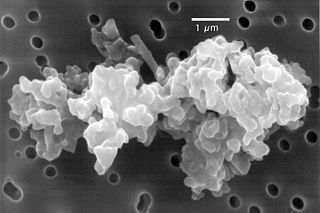
Cosmic dust – also called extraterrestrial dust, space dust, or star dust – is dust that occurs in outer space or has fallen onto Earth. Most cosmic dust particles measure between a few molecules and 0.1 mm (100 μm), such as micrometeoroids and meteoroids. Cosmic dust can be further distinguished by its astronomical location: intergalactic dust, interstellar dust, interplanetary dust, and circumplanetary dust. There are several methods to obtain space dust measurement.

The Red Rectangle Nebula, so called because of its red color and unique rectangular shape, is a protoplanetary nebula in the Monoceros constellation. Also known as HD 44179, the nebula was discovered in 1973 during a rocket flight associated with the AFCRL Infrared Sky Survey called Hi Star. The binary system at the center of the nebula was first discovered by Robert Grant Aitken in 1915.

A Herbig Ae/Be star (HAeBe) is a pre-main-sequence star – a young star of spectral types A or B. These stars are still embedded in gas-dust envelopes and are sometimes accompanied by circumstellar disks. Hydrogen and calcium emission lines are observed in their spectra. They are 2-8 Solar mass (M☉) objects, still existing in the star formation stage and approaching the main sequence.

Exozodiacal dust is 1–100 micrometre-sized grains of amorphous carbon and silicate dust that fill the plane of extrasolar planetary systems. It is the exoplanetary analog of zodiacal dust, the 1–100 micrometre-sized dust grains observed in the solar system, especially interior to the asteroid belt. As with the zodiacal dust, these grains are probably produced by outgassing comets, as well as by collisions among bigger parent bodies like asteroids. Exozodiacal dust clouds are often components of debris disks that are detected around main-sequence stars through their excess infrared emission. Particularly hot exozodiacal disks are also commonly found near spectral type A-K stars. By convention, exozodiacal dust refers to the innermost and hottest part of these debris disks, within a few astronomical units of the star. How exozodiacal dust is so prevalent this close to stars is a subject of debate with several competing theories attempting to explain the phenomenon. The shapes of exozodiacal dust clouds can show the dynamical influence of extrasolar planets, and potentially indicate the presence of these planets. Because it is often located near a star's habitable zone, exozodiacal dust can be an important noise source for attempts to image terrestrial planets. Around 1 in 100 stars in the nearby solar systems shows a high content of warm dust that is around 1000 times greater than the average dust emission in the 8.5–12 μm range.
51 Ophiuchi is a single star located approximately 410 light years away from the Sun in the equatorial constellation of Ophiuchus, northwest of the center of the Milky Way. It is visible to the naked eye as a faint, blue-white point of light with an apparent visual magnitude of 4.81. The star is moving closer to the Earth with a heliocentric radial velocity of –12 km/s.
Interstellar ice consists of grains of volatiles in the ice phase that form in the interstellar medium. Ice and dust grains form the primary material out of which the Solar System was formed. Grains of ice are found in the dense regions of molecular clouds, where new stars are formed. Temperatures in these regions can be as low as 10 K, allowing molecules that collide with grains to form an icy mantle. Thereafter, atoms undergo thermal motion across the surface, eventually forming bonds with other atoms. This results in the formation of water and methanol. Indeed, the ices are dominated by water and methanol, as well as ammonia, carbon monoxide and carbon dioxide. Frozen formaldehyde and molecular hydrogen may also be present. Found in lower abundances are nitriles, ketones, esters and carbonyl sulfide. The mantles of interstellar ice grains are generally amorphous, becoming crystalline only in the presence of a star.
The unidentified infrared emission bands are infrared discrete emissions from circumstellar regions, interstellar media, star-forming regions and extragalactic objects for which the identity of the emitting materials is unknown. The main infrared features occur around 3.3, 6.2, 7.7, 8.6, 11.2, and 12.7 μm, although there are many other weak emission features within the ~ 5–19 μm spectral range. In the 1980s, astronomers discovered that the origin of the UIR emission bands is inherent in compounds made of aromatic C–H and C=C chemical bonds, and some went on to hypothesize that the materials responsible should be polycyclic aromatic hydrocarbon (PAH) molecules. Nevertheless, data recorded with the ESA's Infrared Space Observatory and NASA's Spitzer Space Telescope have suggested that the UIR emission bands arise from compounds that are far more complex in composition and structure than PAH molecules. Moreover, the UIR bands follow a clear evolutionary spectral trend that is linked to the lifespan of the astronomical source; from the time the UIR bands first appear around evolved stars in the protoplanetary nebula stage to evolved stages such as the planetary nebula phase.
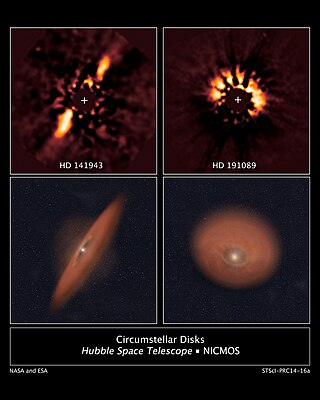
A circumstellar disc is a torus, pancake or ring-shaped accretion disk of matter composed of gas, dust, planetesimals, asteroids, or collision fragments in orbit around a star. Around the youngest stars, they are the reservoirs of material out of which planets may form. Around mature stars, they indicate that planetesimal formation has taken place, and around white dwarfs, they indicate that planetary material survived the whole of stellar evolution. Such a disc can manifest itself in various ways.
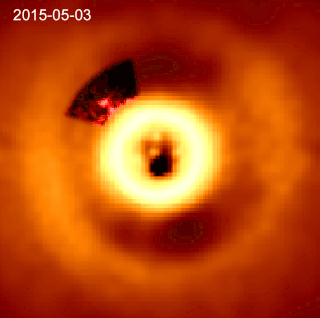
HD 169142 is a single Herbig Ae/Be star. Its surface temperature is 7650±150 K. HD 169142 is depleted of heavy elements compared to the Sun, with a metallicity Fe/H index of −0.375±0.125, but is much younger at an age of 7.5±4.5 million years. The star is rotating slowly and has relatively low stellar activity for a Herbig Ae/Be star.

WISE J080822.18-644357.3, also called J0808, is a 45+11
−7 Myr old star system in the Carina constellation with a circumstellar debris disk orbiting an M-type red dwarf about 331 lightyears from Earth.
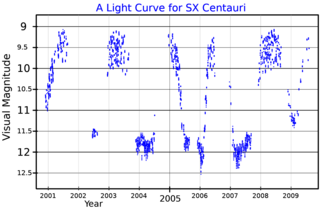
SX Centauri is a variable star in the constellation Centaurus. An RV Tauri variable, its light curve alternates between deep and shallow minima, varying its apparent magnitude from 9.1 to 12.4. From the period-luminosity relationship, it is estimated to be around 1.6 kpc from Earth. Gaia Data Release 2 gives a parallax of 0.2175 mas, corresponding to distance of about 4,600 pc.

EU Andromedae is a carbon star in the constellation Andromeda. Its apparent visual magnitude varies in an irregular manner between 10.7 and 11.8.

A circumplanetary disk is a torus, pancake or ring-shaped accumulation of matter composed of gas, dust, planetesimals, asteroids or collision fragments in orbit around a planet. They are reservoirs of material out of which moons may form. Such a disk can manifest itself in various ways.

WD 0145+234 is a white dwarf star approximately 95 ly (29 pc) from Earth in the constellation of Aries that has been associated with studies suggesting that a very large exoasteroid near the star was substantially disrupted, resulting in a considerable amount of dust and debris around the star. Alternatively, the outburst around WD 0145+234 is explained with ongoing collisions between planetesimals inside the dusty debris disk around the white dwarf.
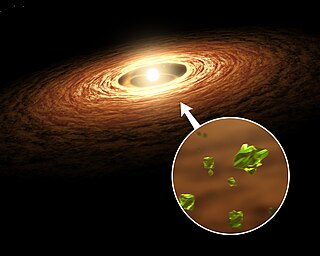
EX Lupi is a young, single T-Tauri star in the southern constellation of Lupus. An irregular variable, it is the prototype of young, low-mass eruptive stars named EXors, with EX Lupi being this object's variable star designation. At its minimal activity level, EX Lupi resembles a classical T-Tauri star of the M0 dwarf type. The low latitude of this star, at a declination of −40°, makes it difficult for northern observers to view. Based on parallax measurements, it is located at a distance of about 505 light years from the Sun. The star lies next to a gap in the Lupus cloud complex, a star forming region.

CQ Tauri is a young variable star in the equatorial constellation of Taurus. It is too faint to be visible to the naked eye with an apparent visual magnitude that ranges from 8.7 to 12.25. The distance to this star is approximately 487 light years based on parallax measurements, and it is drifting further away with a radial velocity of ~23 km/s. It appears to be part of the T-association Tau 4. CQ Tauri lies close enough to the ecliptic to undergo lunar occultations.
References
- ↑ Nakada, Y.; Honma, M.; Seki, M. (2003). Mass-Losing Pulsating Stars and their Circumstellar Matter: Observations and Theory. Dordrecht: Kluwer Academic Publishers. p. 258. ISBN 1402011628.
- 1 2 Käufl, Hans U.; Siebenmorgen, Ralf (2013). The Role of Dust in the Formation of Stars: Proceedings of the ESO Workshop Held at Garching, Germany, 11–14 September 1995. Berlin: Springer Science & Business Media. p. 170. ISBN 9783662225158.
- ↑ Hony, Sacha (2003). Infrared Light on the Composition of the Dust Surrounding Carbon-Rich Stars. Amsterdam: Amsterdam University Press. p. 7. ISBN 9053566686.
- ↑ Jones, Anthony P. (2019). "The mineralogy of cosmic dust: astromineralogy". European Journal of Mineralogy. 19 (6): 771–782. doi:10.1127/0935-1221/2007/0019-1766.
